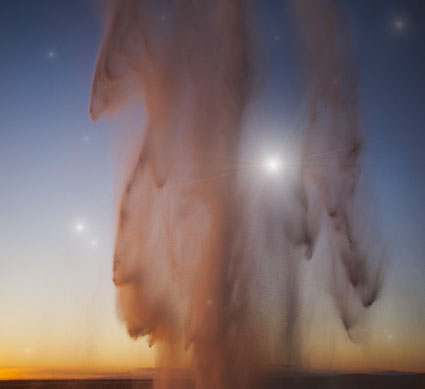Stay In The Zone – The Story Behind The Photograph
Constellation VI, Selljalandsfoss, Iceland, 2012
I had tried my hand at this subject and failed a number of times. It was easy to make the standard high-impact postcard images of this famous location. Selljalandsfoss, Iceland is a marvelous waterfall that you can circle in front of, around, behind and back again. It’s particularly dramatic in the winter when the stairs that lead behind it freeze over and the walls around it freeze up forming icy stalactites of all sizes that periodically crash to the ground. It’s particularly divine on evenings when the setting sun sets the sky and the waterfall afire. In all the times I’ve visited Selljalandsfoss, the light has been like this only twice. Good enough results the first time lead to my knowing what I needed to do to excel – and I was able to do it. Well before sunset, I walked behind the waterfall, and sat quietly without interruption for the better part of two hours, listening to the thundering sound of the cascading water, feeling its vibrations in my body, and watching the water slowly change color from white, to cream, to gold, to pink, to coral, to mauve, to lavender, to gray, to black. I never took my eyes off the water, seeing endless patterns continually appearing, disappearing, and reappearing. I was enthralled, enchanted, transported in one of the more intensely inspiring moments of my life. I made a thousand exposures and collected enough material for a body of work. When you’re in the zone you stay there and you don’t do anything that might disrupt your flow.
What specifically is flow? A mental state when people are completely absorbed with energized focus while harnessing emotions aligned with performing and learning activities. Some say that how and when flow happens is a mystery; they give up on solving this riddle because there are so many conditions that contribute to failing to achieve, sustain, and disrupt flow – and they vary between individuals and individual moments. Others love mysteries, like flow; they look to the most common causes for achieving and sustaining flow and incorporate individual differences and sensitivity to current conditions into attempts to achieve and maintain it. Psychologist Mihaly Csikszentmihalyi suggests that we enter states of flow or peak performance when we rise to challenges that interest and stretch us but aren’t beyond our ability to meet, placing us in a curious emotional state that lies between the poles of boredom and anxiety. Throughout the ages, cultures have studied flow (using many different names) and we continue to learn more and more about it every day. My recommendation is that you, too, study flow – personally.
For instance, from previous experiences, I know I tend to achieve states of flow more frequently and more deeply when I connect with a subject emotionally and my understanding of it is deep enough to ask more specific questions while creating something in a way that involves physical activity with sustained concentration. The natural world is almost always involved in some way. Reflection before, meditation during, and contemplation after all aid this process for me.
You can profit from other people’s experiences of flow, what they create in it, and the paths they find to it, but don’t expect yours to be identical – your experience may be very different. In your study of flow, beware of limiting attitudes and superstitious behavior. Above all, pursue flow actively. Take action. Don’t ask, “What happens if …?” hypothetically and preemptively. Instead, ask “What happens when … ?” during practical experimentation. Then, look at probabilities and stack them in your favor. All you need to do is to find your tipping point(s) and trigger them. How do you know when you’re in the zone? You’ll know. And so will everyone else. When you’re in the zone, there’s no denying it. You’re usually there when you’re doing your best work and feel most alive.
Questions
What are the benefits of being in the zone?
How do you know when you’re in the zone?
What does it take for you to get into the zone?
What can you do to get into the zone faster?
What can you do to get into the zone more frequently?
What can you do to stay in the zone longer?
Find out more about this image here.



Jeffrey
02.12.2013 at 09:44As you say John Paul, you will know when your in the zone.
For me it seems to be a combination of near perfect light and amazing natural phenomenon.
It can be planned or spontaneous, or a combination of both.
You feel it in your body and mind, adrenaline and the scene just take you over.
There will be several hundred images. It is all very exciting. Excited to shoot, excited to view, edit and print. It puts a smile on my face thinking about it!
That is my “Zone”